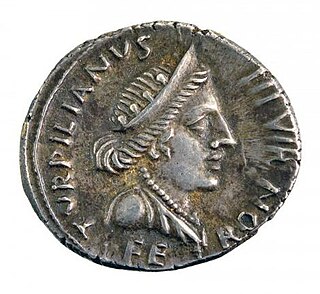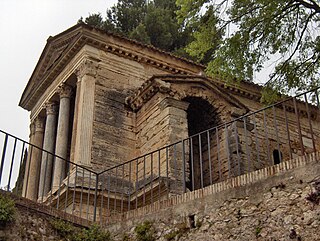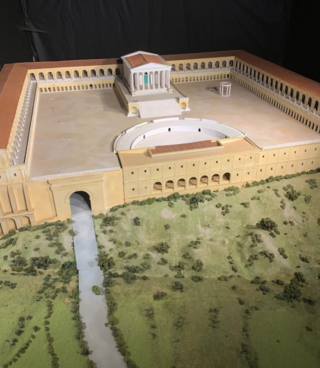
The Capitolium or Capitoline Hill, between the Forum and the Campus Martius, is one of the Seven Hills of Rome.

In Etruscan and Sabine religion, Feronia was a goddess associated with wildlife, fertility, health, and abundance, also venerated by the Faliscans and later adopted into ancient Roman religion. As the goddess who granted freedom to slaves or civil rights to the most humble part of society, she was especially honored among plebeians and freedmen. Her festival, the Feroniae, was November 13 during the Ludi Plebeii, in conjunction with Fortuna Primigenia; both were goddesses of Praeneste.

The Temple of Jupiter Optimus Maximus, also known as the Temple of Jupiter Capitolinus, was the most important temple in Ancient Rome, located on the Capitoline Hill. It was surrounded by the Area Capitolina, a precinct where numerous shrines, altars, statues and victory trophies were displayed.

Terracina is an Italian city and comune of the province of Latina, located on the coast 56 km (35 mi) southeast of Rome on the Via Appia. The site has been continuously occupied since antiquity.

Cupra Marittima is in the Province of Ascoli Piceno in the Italian region Marche, located about 70 km (43 mi) southeast of Ancona and about 30 km (19 mi) northeast of Ascoli Piceno.

The Temple of Jupiter Stator was a sanctuary at the foot of the Palatine Hill in Rome. In Roman legend, it was founded by the first king of Rome, Romulus, honoring a pledge he had made during a battle between the Romans and the Sabines. However, no temple seems to have been built on the site until the early 3rd century BC.

Capo Colonna is a cape in Calabria located near Crotone. In ancient Roman times the promontory was called Promunturium Lacinium. The modern name derives from the remaining column of the Temple of Hera Lacinia.

Circeii was an ancient Roman city on the site of modern San Felice Circeo and near Mount Circeo, the mountain promontory on the southwest coast of Italy. The area around Circeii and Mount Circeo was thickly populated with Roman villas and other buildings, of which the remains of many can still be seen.

The so-called Temple of Clitumnus is a small early medieval church that sits along the banks of the Clitunno river in the town of Pissignano near Campello sul Clitunno, Umbria, Italy. In 2011, it became a UNESCO World Heritage Site as part of a group of seven such sites that mark the presence of Longobards in Italy: Places of Power.

The Archaeological Park of Urbs Salvia is situated in the comune of Urbisaglia, in the Marches, Italy. It is the largest archaeological park in the region.
The Sacro Monte di Graglia is one of the numerous devotional places around the Italian Alps and it houses the Santuario di Nostra Signora di Loreto, one of the four major sanctuaries of the Biellese territory. Set in the Valle Elvo at 690 m on the sea level, the sanctuary is built near the Lauretana water industry.

The Temple of Jupiter Custos was a minor temple in Rome, probably on the Capitoline Hill. It was built by Domitian in memory of his narrow escape from the Capitol during Vitellius' siege. Its site is uncertain – some scholars place it on the rectangular podium in opus caementicium with basalt chips discovered in the 19th century during the construction of via del Tempio di Giove. However, that rectangular plan does not seem compatible with a temple, which a relief in the Palazzo dei Conservatori places to the right of the Temple of Jupiter Optimus Maximus.

The sanctuary or Shrine of Hercules Curinus was an Italic and later Roman sanctuary, the ruins of which are located in the comune of Sulmona, in the province of L'Aquila in the Abruzzo region of Italy.

The Nuragic sanctuary of Santa Vittoria is an archaeological site located in the municipality of Serri, Sardinia – Italy. The name refers to the Romanesque style church built over a place of Roman worship which rises at the westernmost tip of the site. The Santa Vittoria site was frequented starting from the first phase of the Nuragic civilization corresponding to Middle Bronze Age. Subsequently, from the late Bronze Age to the early Iron Age, the place became one of the most important expressions of the Nuragic civilization and today it constitutes the most important Nuragic complex so far excavated.

The Santuario del Noce is a 15th-century Roman Catholic chapel or place of worship dedicated to Anthony of Padua in Camposampiero, Veneto, Italy.

The Sanctuary of Hercules Victor in Tivoli (Italy) was one of the major complexes of the Roman Republican era built on the wave of the Hellenistic cultural influence after the final Roman conquest of Greece. It was built just outside the ancient city of Tibur and is the largest of Italic sanctuaries dedicated to Hercules, and the second in the whole Mediterranean after that of Cádiz in Spain. It was built between about 120 and 82 BC and was a masterpiece of Roman engineering with many innovations. Further building was done in the Augustan period especially in the theatre area. Augustus administered justice here on numerous occasions, under the arcades of the sanctuary.
The ancient Sanctuary of Venus at Hispellum was a grandiose theatre-temple-amphitheatre complex, today located partially in the grounds of the Villa Fidelia to the northwest of the city. It was located outside the walls of the ancient city on a slope near the bottom of the Spello hill facing west as part of an impressive monumental layout.

The sanctuary of Maria Santissima della Rotonda, formerly known as Santa Maria Maggiore, is an important Marian sanctuary in Lazio, located in the city of Albano Laziale, in the province of Rome, in the Roman Castles area.

The temple of Minerva is an archaeological area located on Mount Castelon, in the municipality of Marano di Valpolicella, in the province of Verona. The site, popular as a sanctuary at least since the 6th century BC, became a place of worship dedicated to Minerva in the 2nd century BC.



















